Operations and Project Management Analysis: TESCO Plc Report
VerifiedAdded on 2020/12/24
|20
|5852
|144
Report
AI Summary
This report provides a comprehensive analysis of operations and project management within TESCO Plc. It begins with an introduction to operations management, defining its principles and how they are implemented within TESCO. The report critiques TESCO's operational strategies, examining areas such as operations planning, distribution, and inventory management. It delves into specific methodologies like Six Sigma and lean principles, assessing their effectiveness within the organization. Furthermore, the report explores continuous improvement plans, including the concept of Kaizen and process re-engineering, and their application in enhancing TESCO's market position. The project life cycle (PLC) is also examined, with an analysis of project methodologies, tools, and leadership. The report concludes with an evaluation of PLC effectiveness using relevant theories and models, providing insights into TESCO's overall operational efficiency and strategic management.
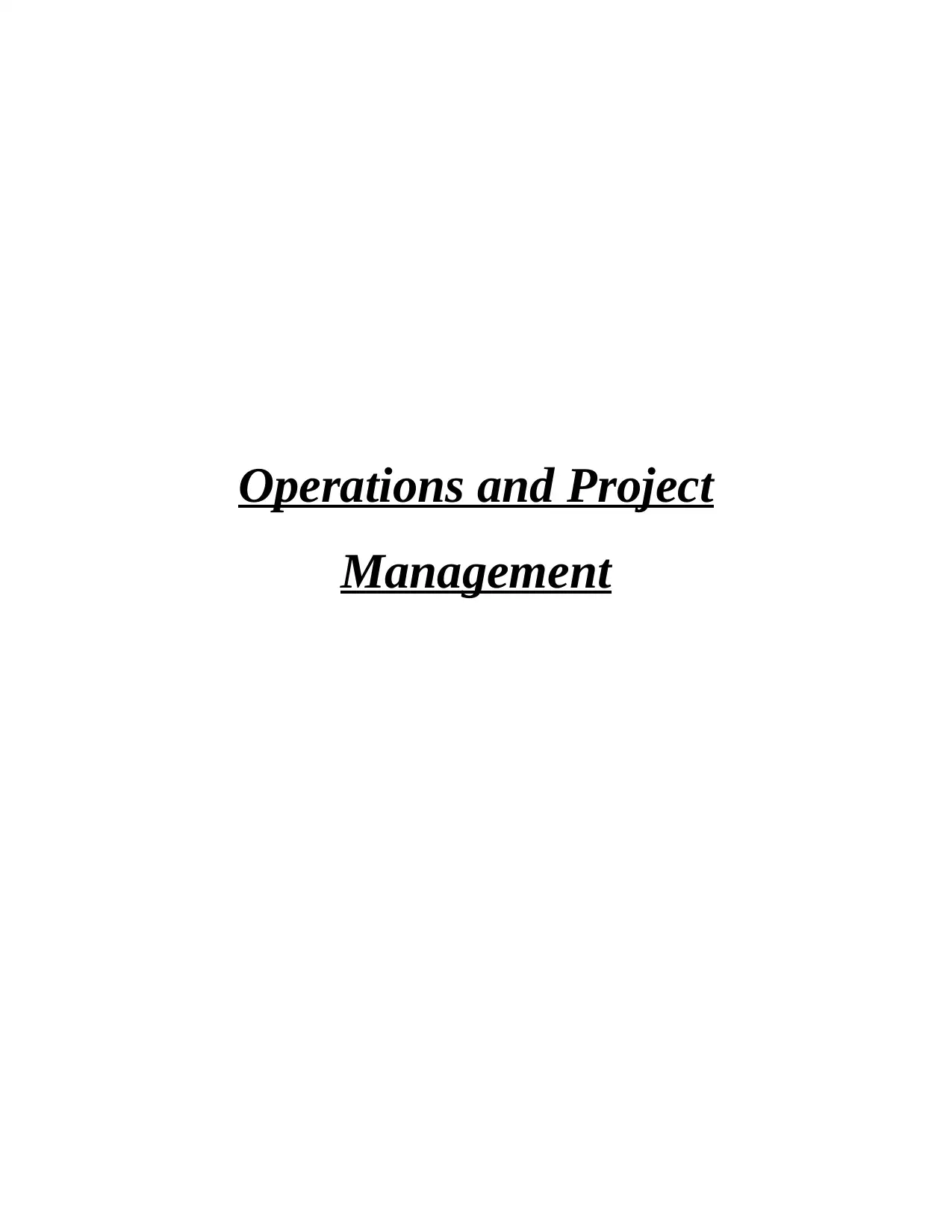
Operations and Project
Management
Management
Paraphrase This Document
Need a fresh take? Get an instant paraphrase of this document with our AI Paraphraser
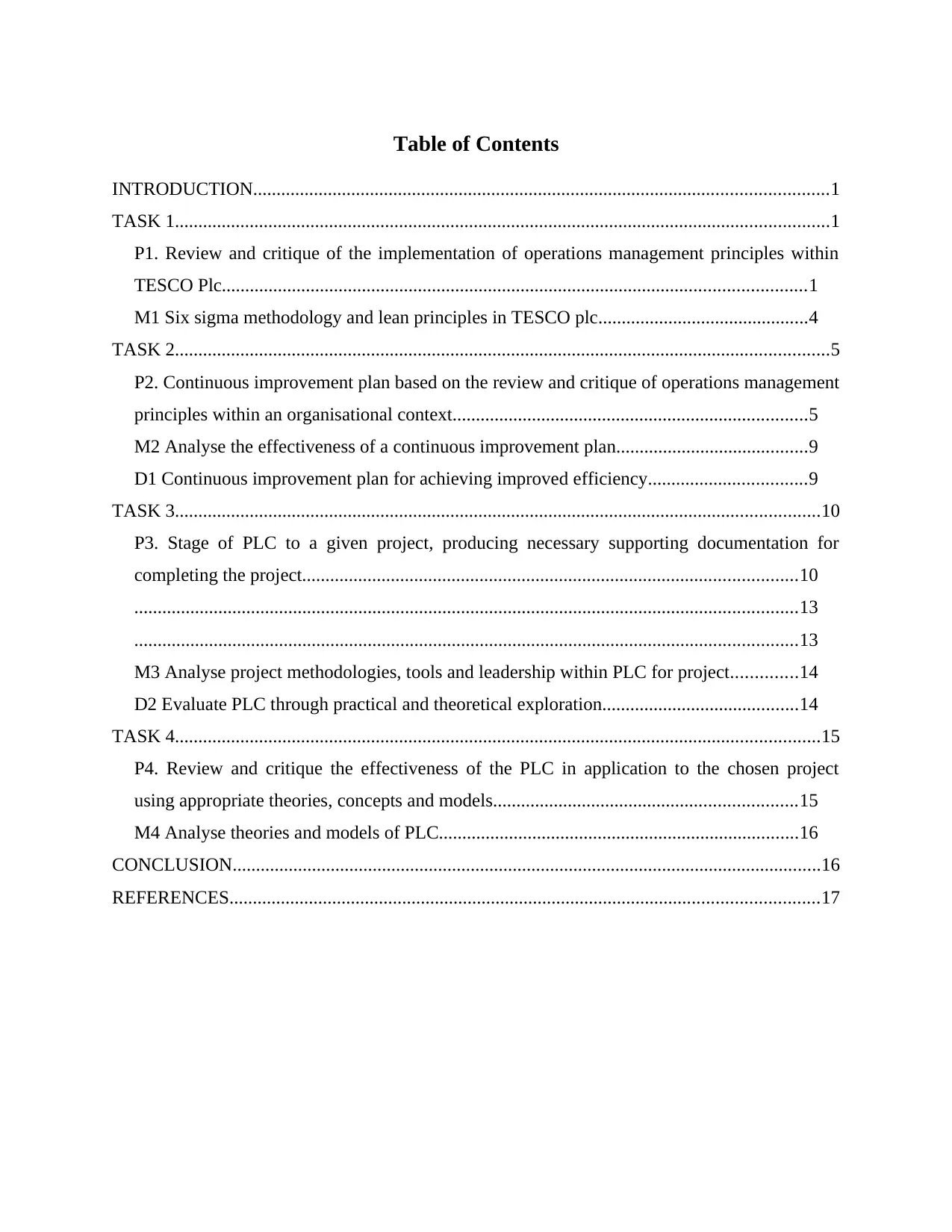
Table of Contents
INTRODUCTION...........................................................................................................................1
TASK 1............................................................................................................................................1
P1. Review and critique of the implementation of operations management principles within
TESCO Plc.............................................................................................................................1
M1 Six sigma methodology and lean principles in TESCO plc.............................................4
TASK 2............................................................................................................................................5
P2. Continuous improvement plan based on the review and critique of operations management
principles within an organisational context............................................................................5
M2 Analyse the effectiveness of a continuous improvement plan.........................................9
D1 Continuous improvement plan for achieving improved efficiency..................................9
TASK 3..........................................................................................................................................10
P3. Stage of PLC to a given project, producing necessary supporting documentation for
completing the project..........................................................................................................10
..............................................................................................................................................13
..............................................................................................................................................13
M3 Analyse project methodologies, tools and leadership within PLC for project..............14
D2 Evaluate PLC through practical and theoretical exploration..........................................14
TASK 4..........................................................................................................................................15
P4. Review and critique the effectiveness of the PLC in application to the chosen project
using appropriate theories, concepts and models.................................................................15
M4 Analyse theories and models of PLC.............................................................................16
CONCLUSION..............................................................................................................................16
REFERENCES..............................................................................................................................17
INTRODUCTION...........................................................................................................................1
TASK 1............................................................................................................................................1
P1. Review and critique of the implementation of operations management principles within
TESCO Plc.............................................................................................................................1
M1 Six sigma methodology and lean principles in TESCO plc.............................................4
TASK 2............................................................................................................................................5
P2. Continuous improvement plan based on the review and critique of operations management
principles within an organisational context............................................................................5
M2 Analyse the effectiveness of a continuous improvement plan.........................................9
D1 Continuous improvement plan for achieving improved efficiency..................................9
TASK 3..........................................................................................................................................10
P3. Stage of PLC to a given project, producing necessary supporting documentation for
completing the project..........................................................................................................10
..............................................................................................................................................13
..............................................................................................................................................13
M3 Analyse project methodologies, tools and leadership within PLC for project..............14
D2 Evaluate PLC through practical and theoretical exploration..........................................14
TASK 4..........................................................................................................................................15
P4. Review and critique the effectiveness of the PLC in application to the chosen project
using appropriate theories, concepts and models.................................................................15
M4 Analyse theories and models of PLC.............................................................................16
CONCLUSION..............................................................................................................................16
REFERENCES..............................................................................................................................17

⊘ This is a preview!⊘
Do you want full access?
Subscribe today to unlock all pages.

Trusted by 1+ million students worldwide
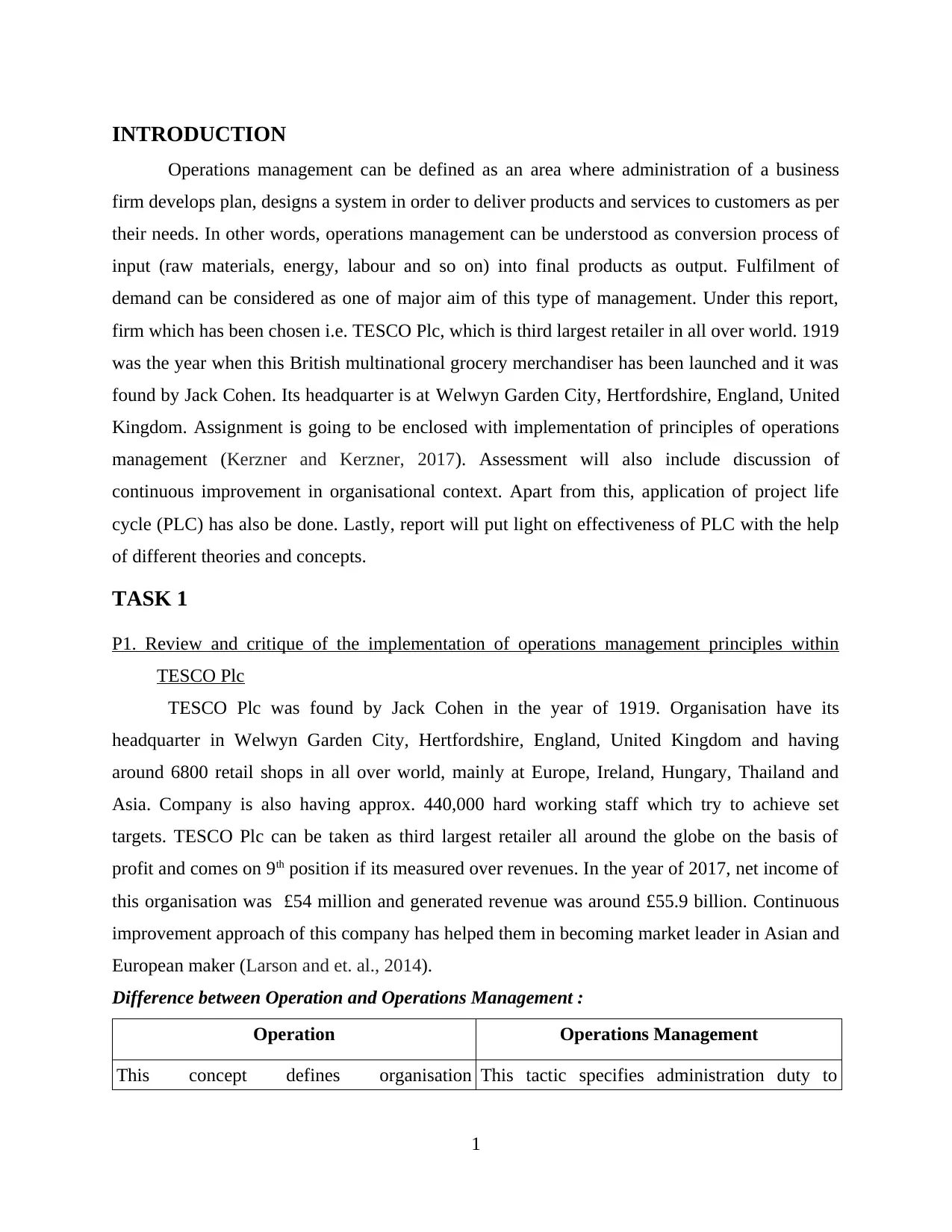
INTRODUCTION
Operations management can be defined as an area where administration of a business
firm develops plan, designs a system in order to deliver products and services to customers as per
their needs. In other words, operations management can be understood as conversion process of
input (raw materials, energy, labour and so on) into final products as output. Fulfilment of
demand can be considered as one of major aim of this type of management. Under this report,
firm which has been chosen i.e. TESCO Plc, which is third largest retailer in all over world. 1919
was the year when this British multinational grocery merchandiser has been launched and it was
found by Jack Cohen. Its headquarter is at Welwyn Garden City, Hertfordshire, England, United
Kingdom. Assignment is going to be enclosed with implementation of principles of operations
management (Kerzner and Kerzner, 2017). Assessment will also include discussion of
continuous improvement in organisational context. Apart from this, application of project life
cycle (PLC) has also be done. Lastly, report will put light on effectiveness of PLC with the help
of different theories and concepts.
TASK 1
P1. Review and critique of the implementation of operations management principles within
TESCO Plc
TESCO Plc was found by Jack Cohen in the year of 1919. Organisation have its
headquarter in Welwyn Garden City, Hertfordshire, England, United Kingdom and having
around 6800 retail shops in all over world, mainly at Europe, Ireland, Hungary, Thailand and
Asia. Company is also having approx. 440,000 hard working staff which try to achieve set
targets. TESCO Plc can be taken as third largest retailer all around the globe on the basis of
profit and comes on 9th position if its measured over revenues. In the year of 2017, net income of
this organisation was £54 million and generated revenue was around £55.9 billion. Continuous
improvement approach of this company has helped them in becoming market leader in Asian and
European maker (Larson and et. al., 2014).
Difference between Operation and Operations Management :
Operation Operations Management
This concept defines organisation This tactic specifies administration duty to
1
Operations management can be defined as an area where administration of a business
firm develops plan, designs a system in order to deliver products and services to customers as per
their needs. In other words, operations management can be understood as conversion process of
input (raw materials, energy, labour and so on) into final products as output. Fulfilment of
demand can be considered as one of major aim of this type of management. Under this report,
firm which has been chosen i.e. TESCO Plc, which is third largest retailer in all over world. 1919
was the year when this British multinational grocery merchandiser has been launched and it was
found by Jack Cohen. Its headquarter is at Welwyn Garden City, Hertfordshire, England, United
Kingdom. Assignment is going to be enclosed with implementation of principles of operations
management (Kerzner and Kerzner, 2017). Assessment will also include discussion of
continuous improvement in organisational context. Apart from this, application of project life
cycle (PLC) has also be done. Lastly, report will put light on effectiveness of PLC with the help
of different theories and concepts.
TASK 1
P1. Review and critique of the implementation of operations management principles within
TESCO Plc
TESCO Plc was found by Jack Cohen in the year of 1919. Organisation have its
headquarter in Welwyn Garden City, Hertfordshire, England, United Kingdom and having
around 6800 retail shops in all over world, mainly at Europe, Ireland, Hungary, Thailand and
Asia. Company is also having approx. 440,000 hard working staff which try to achieve set
targets. TESCO Plc can be taken as third largest retailer all around the globe on the basis of
profit and comes on 9th position if its measured over revenues. In the year of 2017, net income of
this organisation was £54 million and generated revenue was around £55.9 billion. Continuous
improvement approach of this company has helped them in becoming market leader in Asian and
European maker (Larson and et. al., 2014).
Difference between Operation and Operations Management :
Operation Operations Management
This concept defines organisation This tactic specifies administration duty to
1
Paraphrase This Document
Need a fresh take? Get an instant paraphrase of this document with our AI Paraphraser
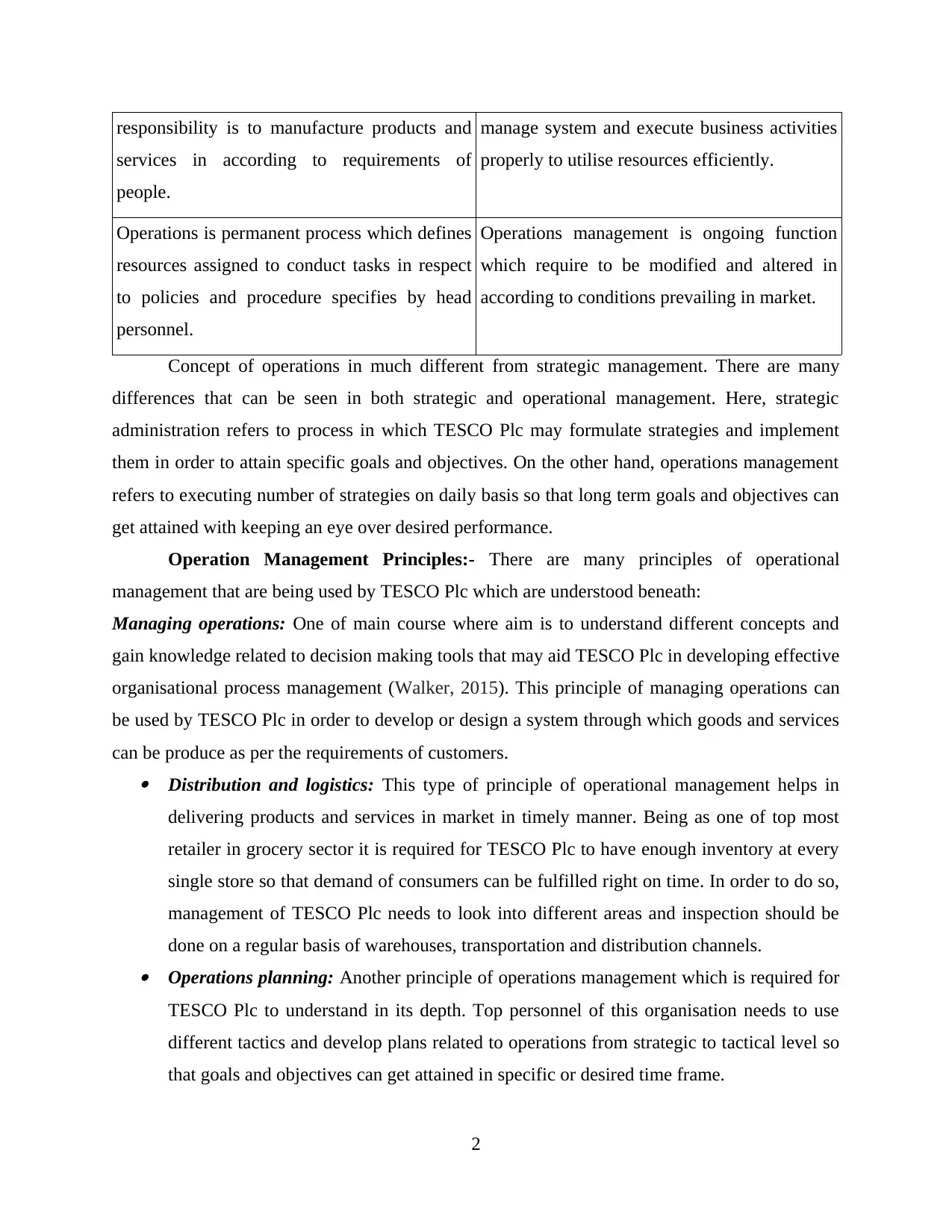
responsibility is to manufacture products and
services in according to requirements of
people.
manage system and execute business activities
properly to utilise resources efficiently.
Operations is permanent process which defines
resources assigned to conduct tasks in respect
to policies and procedure specifies by head
personnel.
Operations management is ongoing function
which require to be modified and altered in
according to conditions prevailing in market.
Concept of operations in much different from strategic management. There are many
differences that can be seen in both strategic and operational management. Here, strategic
administration refers to process in which TESCO Plc may formulate strategies and implement
them in order to attain specific goals and objectives. On the other hand, operations management
refers to executing number of strategies on daily basis so that long term goals and objectives can
get attained with keeping an eye over desired performance.
Operation Management Principles:- There are many principles of operational
management that are being used by TESCO Plc which are understood beneath:
Managing operations: One of main course where aim is to understand different concepts and
gain knowledge related to decision making tools that may aid TESCO Plc in developing effective
organisational process management (Walker, 2015). This principle of managing operations can
be used by TESCO Plc in order to develop or design a system through which goods and services
can be produce as per the requirements of customers. Distribution and logistics: This type of principle of operational management helps in
delivering products and services in market in timely manner. Being as one of top most
retailer in grocery sector it is required for TESCO Plc to have enough inventory at every
single store so that demand of consumers can be fulfilled right on time. In order to do so,
management of TESCO Plc needs to look into different areas and inspection should be
done on a regular basis of warehouses, transportation and distribution channels. Operations planning: Another principle of operations management which is required for
TESCO Plc to understand in its depth. Top personnel of this organisation needs to use
different tactics and develop plans related to operations from strategic to tactical level so
that goals and objectives can get attained in specific or desired time frame.
2
services in according to requirements of
people.
manage system and execute business activities
properly to utilise resources efficiently.
Operations is permanent process which defines
resources assigned to conduct tasks in respect
to policies and procedure specifies by head
personnel.
Operations management is ongoing function
which require to be modified and altered in
according to conditions prevailing in market.
Concept of operations in much different from strategic management. There are many
differences that can be seen in both strategic and operational management. Here, strategic
administration refers to process in which TESCO Plc may formulate strategies and implement
them in order to attain specific goals and objectives. On the other hand, operations management
refers to executing number of strategies on daily basis so that long term goals and objectives can
get attained with keeping an eye over desired performance.
Operation Management Principles:- There are many principles of operational
management that are being used by TESCO Plc which are understood beneath:
Managing operations: One of main course where aim is to understand different concepts and
gain knowledge related to decision making tools that may aid TESCO Plc in developing effective
organisational process management (Walker, 2015). This principle of managing operations can
be used by TESCO Plc in order to develop or design a system through which goods and services
can be produce as per the requirements of customers. Distribution and logistics: This type of principle of operational management helps in
delivering products and services in market in timely manner. Being as one of top most
retailer in grocery sector it is required for TESCO Plc to have enough inventory at every
single store so that demand of consumers can be fulfilled right on time. In order to do so,
management of TESCO Plc needs to look into different areas and inspection should be
done on a regular basis of warehouses, transportation and distribution channels. Operations planning: Another principle of operations management which is required for
TESCO Plc to understand in its depth. Top personnel of this organisation needs to use
different tactics and develop plans related to operations from strategic to tactical level so
that goals and objectives can get attained in specific or desired time frame.
2
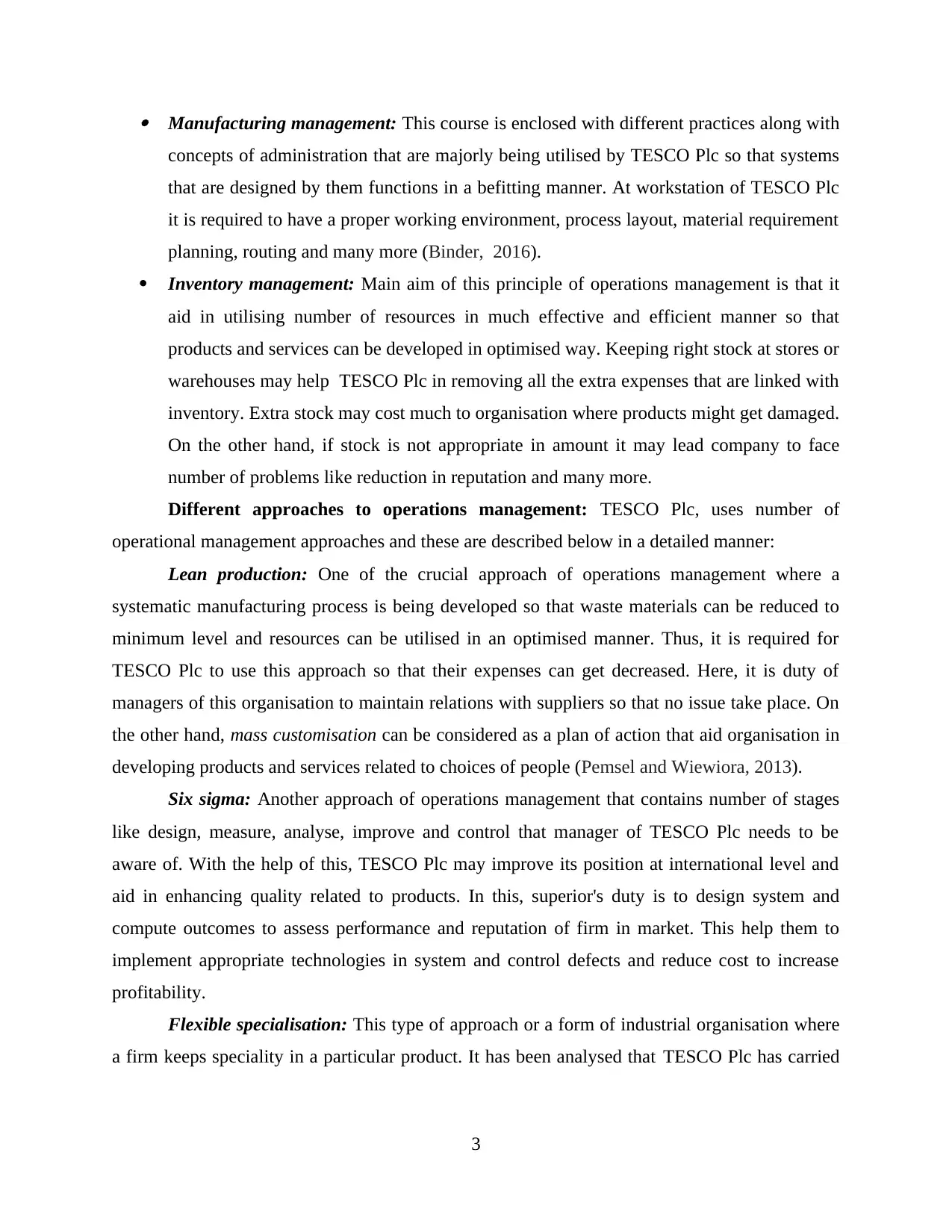
Manufacturing management: This course is enclosed with different practices along with
concepts of administration that are majorly being utilised by TESCO Plc so that systems
that are designed by them functions in a befitting manner. At workstation of TESCO Plc
it is required to have a proper working environment, process layout, material requirement
planning, routing and many more (Binder, 2016).
Inventory management: Main aim of this principle of operations management is that it
aid in utilising number of resources in much effective and efficient manner so that
products and services can be developed in optimised way. Keeping right stock at stores or
warehouses may help TESCO Plc in removing all the extra expenses that are linked with
inventory. Extra stock may cost much to organisation where products might get damaged.
On the other hand, if stock is not appropriate in amount it may lead company to face
number of problems like reduction in reputation and many more.
Different approaches to operations management: TESCO Plc, uses number of
operational management approaches and these are described below in a detailed manner:
Lean production: One of the crucial approach of operations management where a
systematic manufacturing process is being developed so that waste materials can be reduced to
minimum level and resources can be utilised in an optimised manner. Thus, it is required for
TESCO Plc to use this approach so that their expenses can get decreased. Here, it is duty of
managers of this organisation to maintain relations with suppliers so that no issue take place. On
the other hand, mass customisation can be considered as a plan of action that aid organisation in
developing products and services related to choices of people (Pemsel and Wiewiora, 2013).
Six sigma: Another approach of operations management that contains number of stages
like design, measure, analyse, improve and control that manager of TESCO Plc needs to be
aware of. With the help of this, TESCO Plc may improve its position at international level and
aid in enhancing quality related to products. In this, superior's duty is to design system and
compute outcomes to assess performance and reputation of firm in market. This help them to
implement appropriate technologies in system and control defects and reduce cost to increase
profitability.
Flexible specialisation: This type of approach or a form of industrial organisation where
a firm keeps speciality in a particular product. It has been analysed that TESCO Plc has carried
3
concepts of administration that are majorly being utilised by TESCO Plc so that systems
that are designed by them functions in a befitting manner. At workstation of TESCO Plc
it is required to have a proper working environment, process layout, material requirement
planning, routing and many more (Binder, 2016).
Inventory management: Main aim of this principle of operations management is that it
aid in utilising number of resources in much effective and efficient manner so that
products and services can be developed in optimised way. Keeping right stock at stores or
warehouses may help TESCO Plc in removing all the extra expenses that are linked with
inventory. Extra stock may cost much to organisation where products might get damaged.
On the other hand, if stock is not appropriate in amount it may lead company to face
number of problems like reduction in reputation and many more.
Different approaches to operations management: TESCO Plc, uses number of
operational management approaches and these are described below in a detailed manner:
Lean production: One of the crucial approach of operations management where a
systematic manufacturing process is being developed so that waste materials can be reduced to
minimum level and resources can be utilised in an optimised manner. Thus, it is required for
TESCO Plc to use this approach so that their expenses can get decreased. Here, it is duty of
managers of this organisation to maintain relations with suppliers so that no issue take place. On
the other hand, mass customisation can be considered as a plan of action that aid organisation in
developing products and services related to choices of people (Pemsel and Wiewiora, 2013).
Six sigma: Another approach of operations management that contains number of stages
like design, measure, analyse, improve and control that manager of TESCO Plc needs to be
aware of. With the help of this, TESCO Plc may improve its position at international level and
aid in enhancing quality related to products. In this, superior's duty is to design system and
compute outcomes to assess performance and reputation of firm in market. This help them to
implement appropriate technologies in system and control defects and reduce cost to increase
profitability.
Flexible specialisation: This type of approach or a form of industrial organisation where
a firm keeps speciality in a particular product. It has been analysed that TESCO Plc has carried
3
⊘ This is a preview!⊘
Do you want full access?
Subscribe today to unlock all pages.

Trusted by 1+ million students worldwide
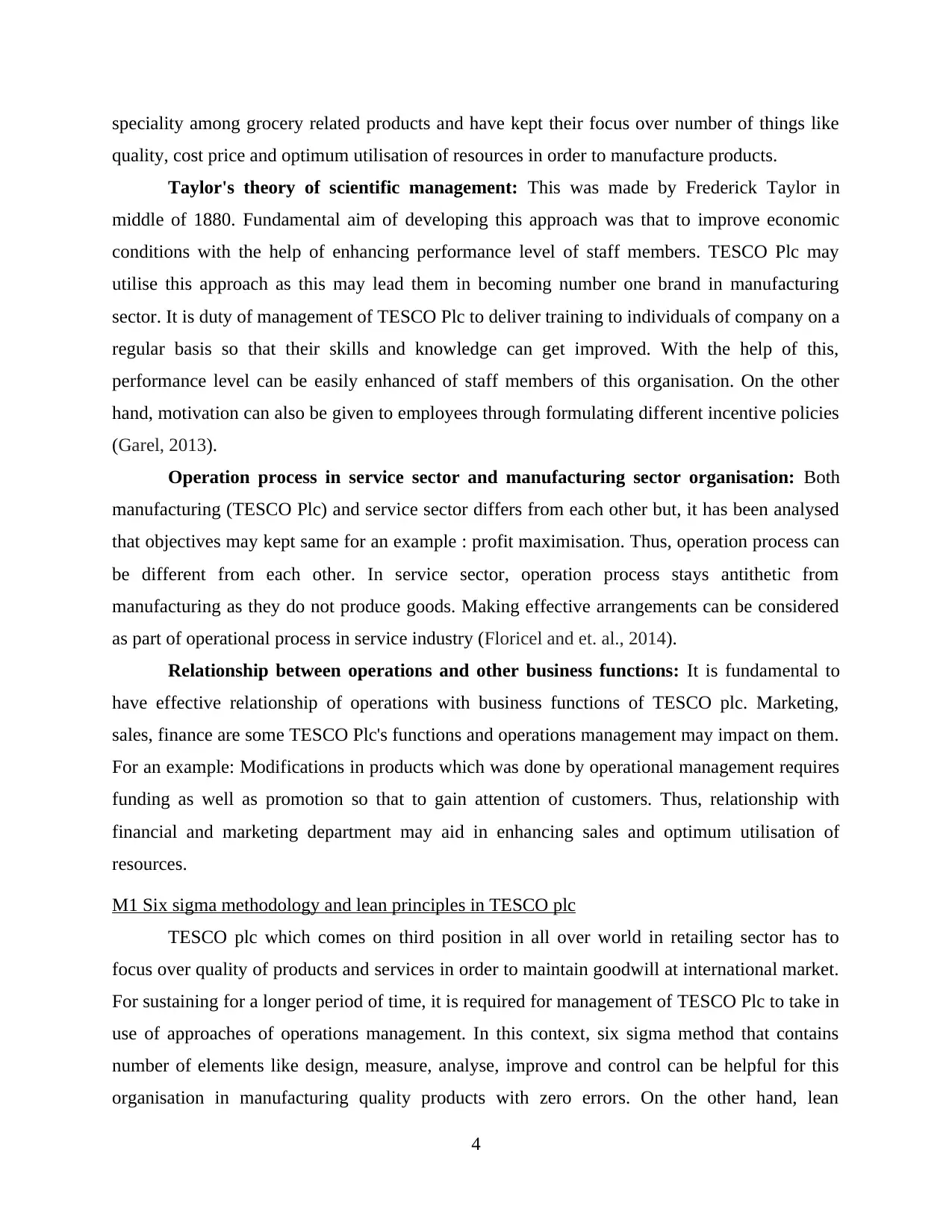
speciality among grocery related products and have kept their focus over number of things like
quality, cost price and optimum utilisation of resources in order to manufacture products.
Taylor's theory of scientific management: This was made by Frederick Taylor in
middle of 1880. Fundamental aim of developing this approach was that to improve economic
conditions with the help of enhancing performance level of staff members. TESCO Plc may
utilise this approach as this may lead them in becoming number one brand in manufacturing
sector. It is duty of management of TESCO Plc to deliver training to individuals of company on a
regular basis so that their skills and knowledge can get improved. With the help of this,
performance level can be easily enhanced of staff members of this organisation. On the other
hand, motivation can also be given to employees through formulating different incentive policies
(Garel, 2013).
Operation process in service sector and manufacturing sector organisation: Both
manufacturing (TESCO Plc) and service sector differs from each other but, it has been analysed
that objectives may kept same for an example : profit maximisation. Thus, operation process can
be different from each other. In service sector, operation process stays antithetic from
manufacturing as they do not produce goods. Making effective arrangements can be considered
as part of operational process in service industry (Floricel and et. al., 2014).
Relationship between operations and other business functions: It is fundamental to
have effective relationship of operations with business functions of TESCO plc. Marketing,
sales, finance are some TESCO Plc's functions and operations management may impact on them.
For an example: Modifications in products which was done by operational management requires
funding as well as promotion so that to gain attention of customers. Thus, relationship with
financial and marketing department may aid in enhancing sales and optimum utilisation of
resources.
M1 Six sigma methodology and lean principles in TESCO plc
TESCO plc which comes on third position in all over world in retailing sector has to
focus over quality of products and services in order to maintain goodwill at international market.
For sustaining for a longer period of time, it is required for management of TESCO Plc to take in
use of approaches of operations management. In this context, six sigma method that contains
number of elements like design, measure, analyse, improve and control can be helpful for this
organisation in manufacturing quality products with zero errors. On the other hand, lean
4
quality, cost price and optimum utilisation of resources in order to manufacture products.
Taylor's theory of scientific management: This was made by Frederick Taylor in
middle of 1880. Fundamental aim of developing this approach was that to improve economic
conditions with the help of enhancing performance level of staff members. TESCO Plc may
utilise this approach as this may lead them in becoming number one brand in manufacturing
sector. It is duty of management of TESCO Plc to deliver training to individuals of company on a
regular basis so that their skills and knowledge can get improved. With the help of this,
performance level can be easily enhanced of staff members of this organisation. On the other
hand, motivation can also be given to employees through formulating different incentive policies
(Garel, 2013).
Operation process in service sector and manufacturing sector organisation: Both
manufacturing (TESCO Plc) and service sector differs from each other but, it has been analysed
that objectives may kept same for an example : profit maximisation. Thus, operation process can
be different from each other. In service sector, operation process stays antithetic from
manufacturing as they do not produce goods. Making effective arrangements can be considered
as part of operational process in service industry (Floricel and et. al., 2014).
Relationship between operations and other business functions: It is fundamental to
have effective relationship of operations with business functions of TESCO plc. Marketing,
sales, finance are some TESCO Plc's functions and operations management may impact on them.
For an example: Modifications in products which was done by operational management requires
funding as well as promotion so that to gain attention of customers. Thus, relationship with
financial and marketing department may aid in enhancing sales and optimum utilisation of
resources.
M1 Six sigma methodology and lean principles in TESCO plc
TESCO plc which comes on third position in all over world in retailing sector has to
focus over quality of products and services in order to maintain goodwill at international market.
For sustaining for a longer period of time, it is required for management of TESCO Plc to take in
use of approaches of operations management. In this context, six sigma method that contains
number of elements like design, measure, analyse, improve and control can be helpful for this
organisation in manufacturing quality products with zero errors. On the other hand, lean
4
Paraphrase This Document
Need a fresh take? Get an instant paraphrase of this document with our AI Paraphraser
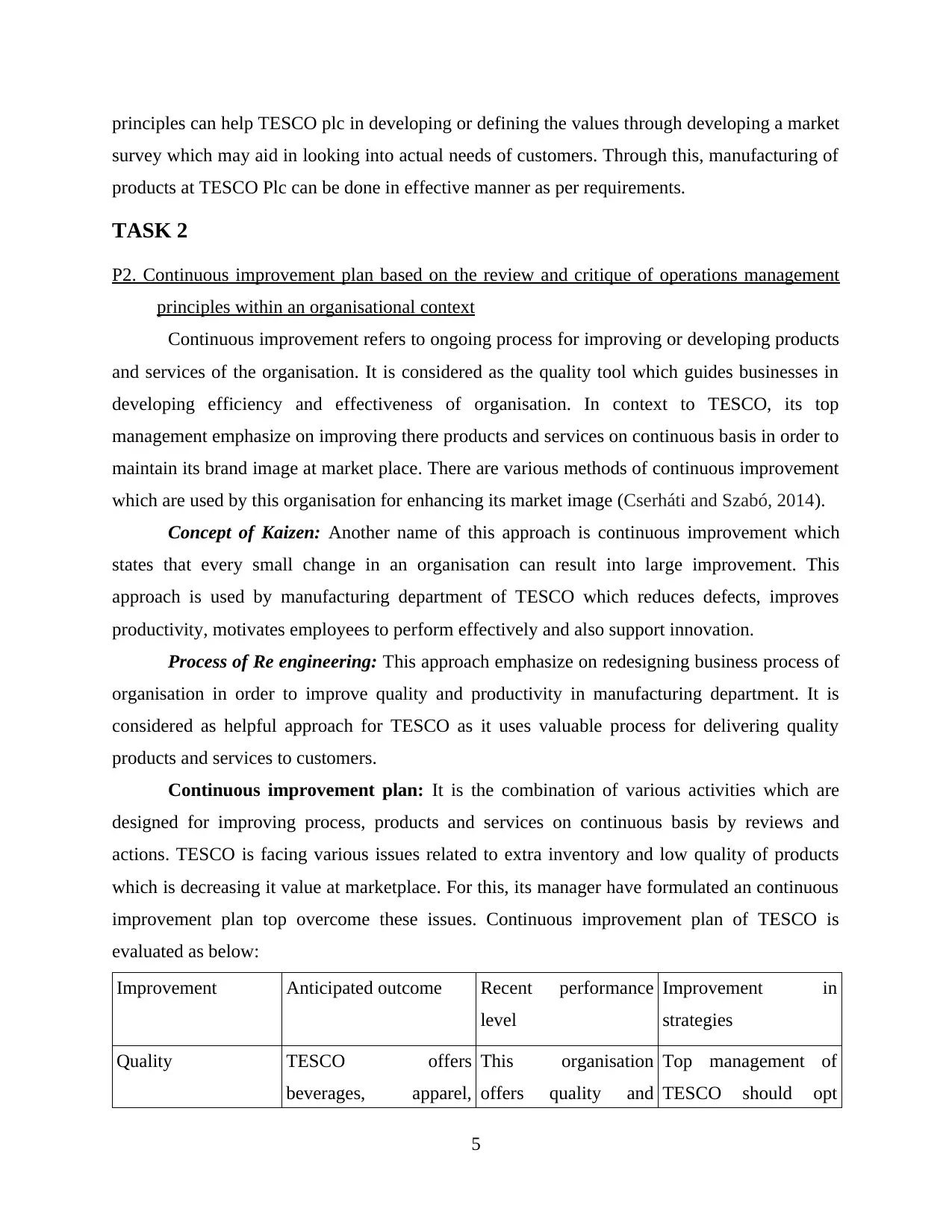
principles can help TESCO plc in developing or defining the values through developing a market
survey which may aid in looking into actual needs of customers. Through this, manufacturing of
products at TESCO Plc can be done in effective manner as per requirements.
TASK 2
P2. Continuous improvement plan based on the review and critique of operations management
principles within an organisational context
Continuous improvement refers to ongoing process for improving or developing products
and services of the organisation. It is considered as the quality tool which guides businesses in
developing efficiency and effectiveness of organisation. In context to TESCO, its top
management emphasize on improving there products and services on continuous basis in order to
maintain its brand image at market place. There are various methods of continuous improvement
which are used by this organisation for enhancing its market image (Cserháti and Szabó, 2014).
Concept of Kaizen: Another name of this approach is continuous improvement which
states that every small change in an organisation can result into large improvement. This
approach is used by manufacturing department of TESCO which reduces defects, improves
productivity, motivates employees to perform effectively and also support innovation.
Process of Re engineering: This approach emphasize on redesigning business process of
organisation in order to improve quality and productivity in manufacturing department. It is
considered as helpful approach for TESCO as it uses valuable process for delivering quality
products and services to customers.
Continuous improvement plan: It is the combination of various activities which are
designed for improving process, products and services on continuous basis by reviews and
actions. TESCO is facing various issues related to extra inventory and low quality of products
which is decreasing it value at marketplace. For this, its manager have formulated an continuous
improvement plan top overcome these issues. Continuous improvement plan of TESCO is
evaluated as below:
Improvement Anticipated outcome Recent performance
level
Improvement in
strategies
Quality TESCO offers
beverages, apparel,
This organisation
offers quality and
Top management of
TESCO should opt
5
survey which may aid in looking into actual needs of customers. Through this, manufacturing of
products at TESCO Plc can be done in effective manner as per requirements.
TASK 2
P2. Continuous improvement plan based on the review and critique of operations management
principles within an organisational context
Continuous improvement refers to ongoing process for improving or developing products
and services of the organisation. It is considered as the quality tool which guides businesses in
developing efficiency and effectiveness of organisation. In context to TESCO, its top
management emphasize on improving there products and services on continuous basis in order to
maintain its brand image at market place. There are various methods of continuous improvement
which are used by this organisation for enhancing its market image (Cserháti and Szabó, 2014).
Concept of Kaizen: Another name of this approach is continuous improvement which
states that every small change in an organisation can result into large improvement. This
approach is used by manufacturing department of TESCO which reduces defects, improves
productivity, motivates employees to perform effectively and also support innovation.
Process of Re engineering: This approach emphasize on redesigning business process of
organisation in order to improve quality and productivity in manufacturing department. It is
considered as helpful approach for TESCO as it uses valuable process for delivering quality
products and services to customers.
Continuous improvement plan: It is the combination of various activities which are
designed for improving process, products and services on continuous basis by reviews and
actions. TESCO is facing various issues related to extra inventory and low quality of products
which is decreasing it value at marketplace. For this, its manager have formulated an continuous
improvement plan top overcome these issues. Continuous improvement plan of TESCO is
evaluated as below:
Improvement Anticipated outcome Recent performance
level
Improvement in
strategies
Quality TESCO offers
beverages, apparel,
This organisation
offers quality and
Top management of
TESCO should opt
5
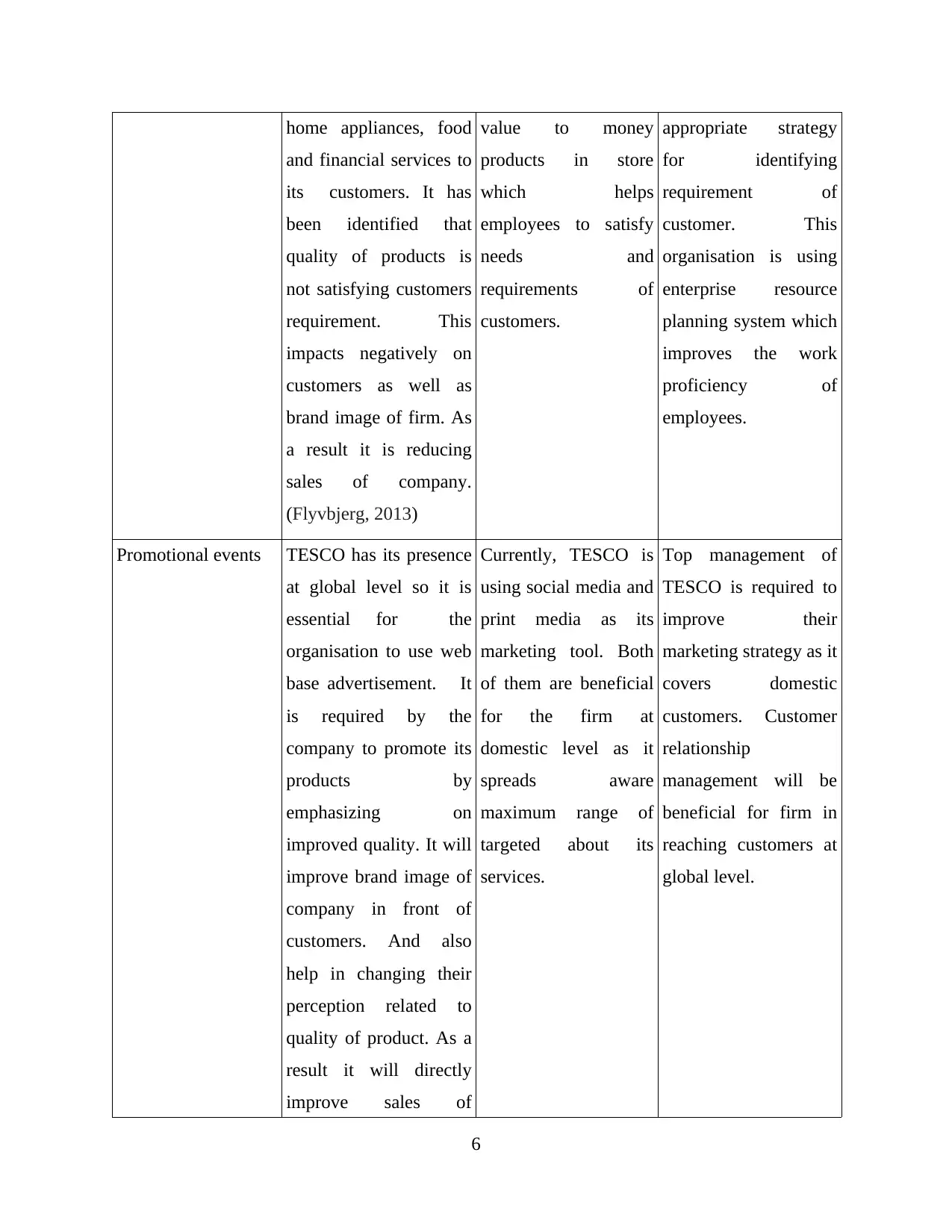
home appliances, food
and financial services to
its customers. It has
been identified that
quality of products is
not satisfying customers
requirement. This
impacts negatively on
customers as well as
brand image of firm. As
a result it is reducing
sales of company.
(Flyvbjerg, 2013)
value to money
products in store
which helps
employees to satisfy
needs and
requirements of
customers.
appropriate strategy
for identifying
requirement of
customer. This
organisation is using
enterprise resource
planning system which
improves the work
proficiency of
employees.
Promotional events TESCO has its presence
at global level so it is
essential for the
organisation to use web
base advertisement. It
is required by the
company to promote its
products by
emphasizing on
improved quality. It will
improve brand image of
company in front of
customers. And also
help in changing their
perception related to
quality of product. As a
result it will directly
improve sales of
Currently, TESCO is
using social media and
print media as its
marketing tool. Both
of them are beneficial
for the firm at
domestic level as it
spreads aware
maximum range of
targeted about its
services.
Top management of
TESCO is required to
improve their
marketing strategy as it
covers domestic
customers. Customer
relationship
management will be
beneficial for firm in
reaching customers at
global level.
6
and financial services to
its customers. It has
been identified that
quality of products is
not satisfying customers
requirement. This
impacts negatively on
customers as well as
brand image of firm. As
a result it is reducing
sales of company.
(Flyvbjerg, 2013)
value to money
products in store
which helps
employees to satisfy
needs and
requirements of
customers.
appropriate strategy
for identifying
requirement of
customer. This
organisation is using
enterprise resource
planning system which
improves the work
proficiency of
employees.
Promotional events TESCO has its presence
at global level so it is
essential for the
organisation to use web
base advertisement. It
is required by the
company to promote its
products by
emphasizing on
improved quality. It will
improve brand image of
company in front of
customers. And also
help in changing their
perception related to
quality of product. As a
result it will directly
improve sales of
Currently, TESCO is
using social media and
print media as its
marketing tool. Both
of them are beneficial
for the firm at
domestic level as it
spreads aware
maximum range of
targeted about its
services.
Top management of
TESCO is required to
improve their
marketing strategy as it
covers domestic
customers. Customer
relationship
management will be
beneficial for firm in
reaching customers at
global level.
6
⊘ This is a preview!⊘
Do you want full access?
Subscribe today to unlock all pages.

Trusted by 1+ million students worldwide
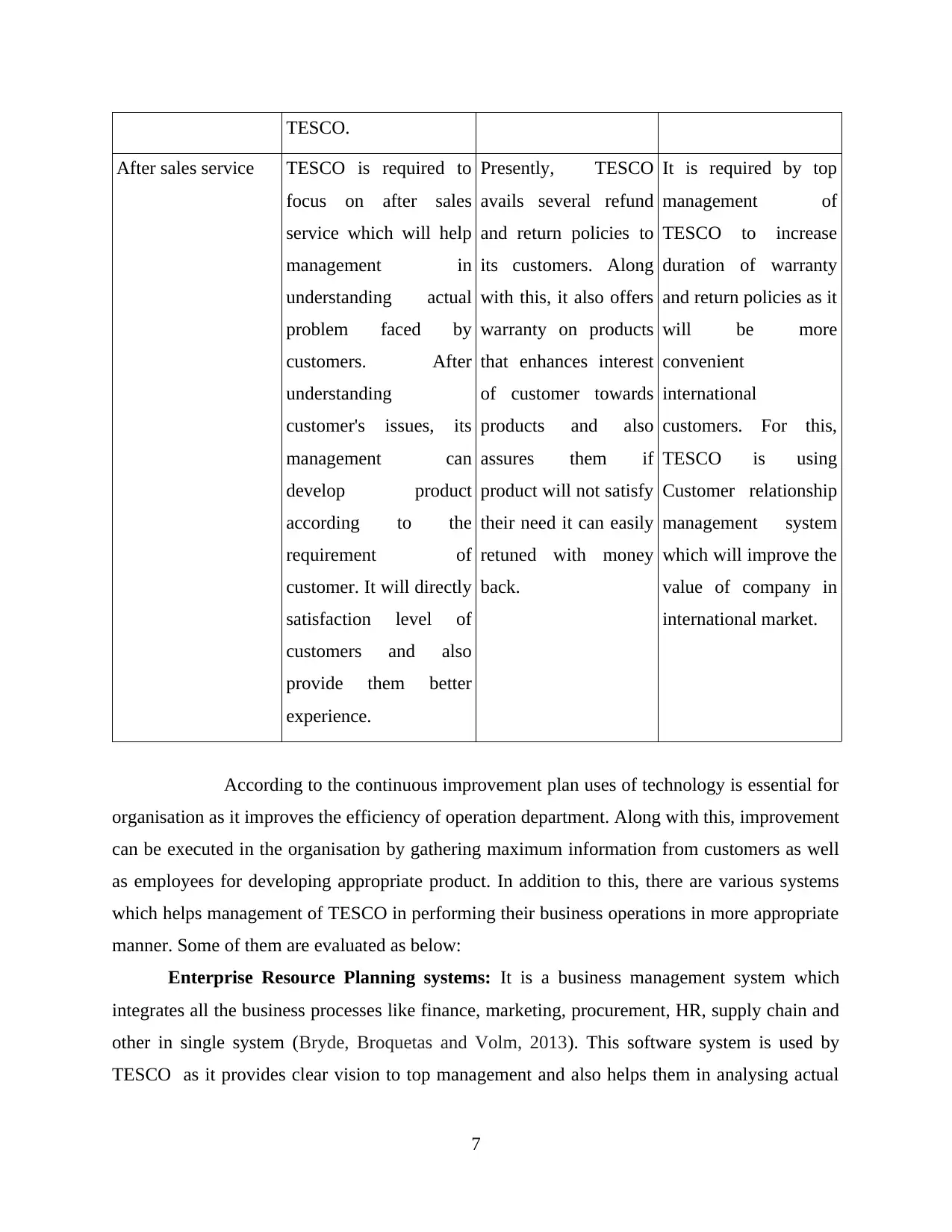
TESCO.
After sales service TESCO is required to
focus on after sales
service which will help
management in
understanding actual
problem faced by
customers. After
understanding
customer's issues, its
management can
develop product
according to the
requirement of
customer. It will directly
satisfaction level of
customers and also
provide them better
experience.
Presently, TESCO
avails several refund
and return policies to
its customers. Along
with this, it also offers
warranty on products
that enhances interest
of customer towards
products and also
assures them if
product will not satisfy
their need it can easily
retuned with money
back.
It is required by top
management of
TESCO to increase
duration of warranty
and return policies as it
will be more
convenient
international
customers. For this,
TESCO is using
Customer relationship
management system
which will improve the
value of company in
international market.
According to the continuous improvement plan uses of technology is essential for
organisation as it improves the efficiency of operation department. Along with this, improvement
can be executed in the organisation by gathering maximum information from customers as well
as employees for developing appropriate product. In addition to this, there are various systems
which helps management of TESCO in performing their business operations in more appropriate
manner. Some of them are evaluated as below:
Enterprise Resource Planning systems: It is a business management system which
integrates all the business processes like finance, marketing, procurement, HR, supply chain and
other in single system (Bryde, Broquetas and Volm, 2013). This software system is used by
TESCO as it provides clear vision to top management and also helps them in analysing actual
7
After sales service TESCO is required to
focus on after sales
service which will help
management in
understanding actual
problem faced by
customers. After
understanding
customer's issues, its
management can
develop product
according to the
requirement of
customer. It will directly
satisfaction level of
customers and also
provide them better
experience.
Presently, TESCO
avails several refund
and return policies to
its customers. Along
with this, it also offers
warranty on products
that enhances interest
of customer towards
products and also
assures them if
product will not satisfy
their need it can easily
retuned with money
back.
It is required by top
management of
TESCO to increase
duration of warranty
and return policies as it
will be more
convenient
international
customers. For this,
TESCO is using
Customer relationship
management system
which will improve the
value of company in
international market.
According to the continuous improvement plan uses of technology is essential for
organisation as it improves the efficiency of operation department. Along with this, improvement
can be executed in the organisation by gathering maximum information from customers as well
as employees for developing appropriate product. In addition to this, there are various systems
which helps management of TESCO in performing their business operations in more appropriate
manner. Some of them are evaluated as below:
Enterprise Resource Planning systems: It is a business management system which
integrates all the business processes like finance, marketing, procurement, HR, supply chain and
other in single system (Bryde, Broquetas and Volm, 2013). This software system is used by
TESCO as it provides clear vision to top management and also helps them in analysing actual
7
Paraphrase This Document
Need a fresh take? Get an instant paraphrase of this document with our AI Paraphraser
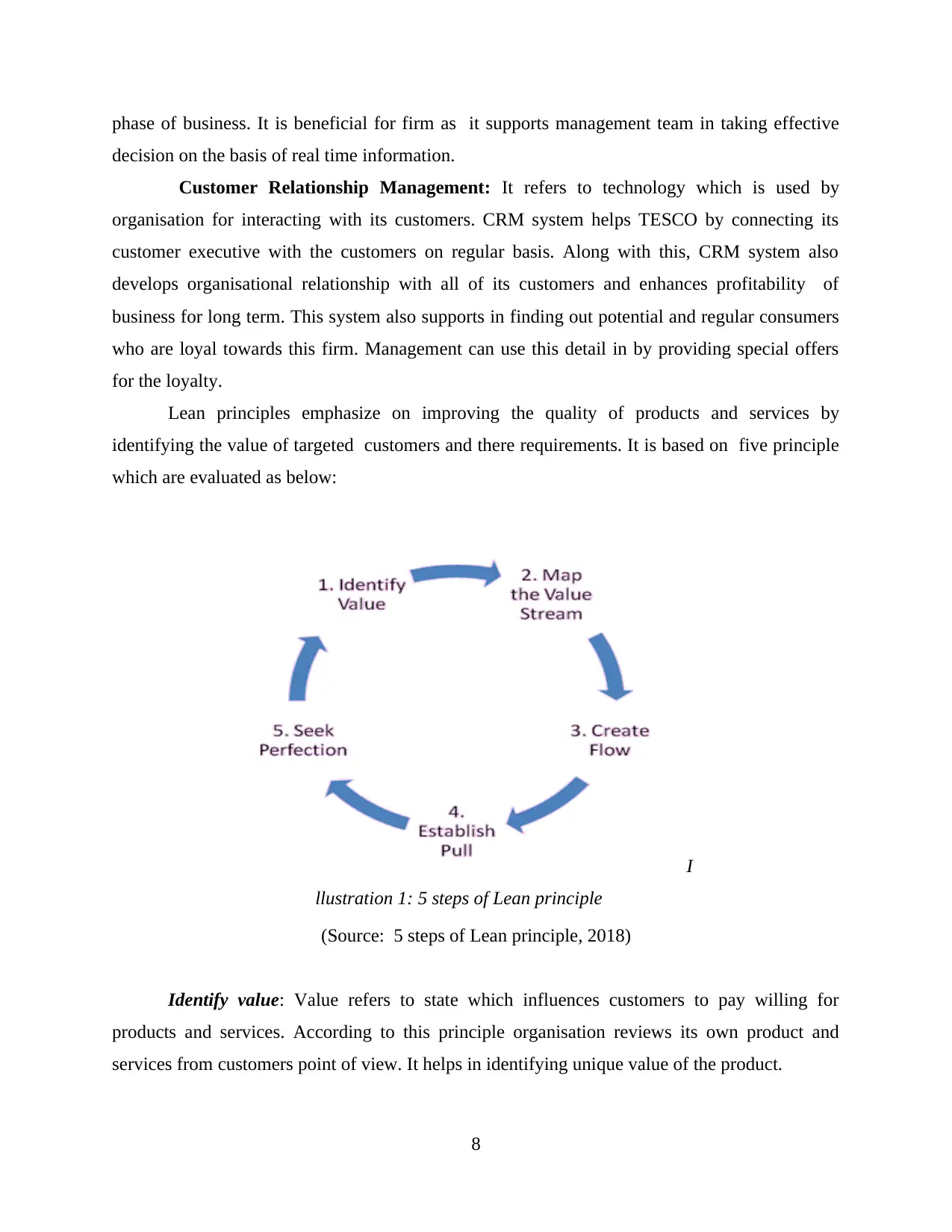
phase of business. It is beneficial for firm as it supports management team in taking effective
decision on the basis of real time information.
Customer Relationship Management: It refers to technology which is used by
organisation for interacting with its customers. CRM system helps TESCO by connecting its
customer executive with the customers on regular basis. Along with this, CRM system also
develops organisational relationship with all of its customers and enhances profitability of
business for long term. This system also supports in finding out potential and regular consumers
who are loyal towards this firm. Management can use this detail in by providing special offers
for the loyalty.
Lean principles emphasize on improving the quality of products and services by
identifying the value of targeted customers and there requirements. It is based on five principle
which are evaluated as below:
(Source: 5 steps of Lean principle, 2018)
Identify value: Value refers to state which influences customers to pay willing for
products and services. According to this principle organisation reviews its own product and
services from customers point of view. It helps in identifying unique value of the product.
8
I
llustration 1: 5 steps of Lean principle
decision on the basis of real time information.
Customer Relationship Management: It refers to technology which is used by
organisation for interacting with its customers. CRM system helps TESCO by connecting its
customer executive with the customers on regular basis. Along with this, CRM system also
develops organisational relationship with all of its customers and enhances profitability of
business for long term. This system also supports in finding out potential and regular consumers
who are loyal towards this firm. Management can use this detail in by providing special offers
for the loyalty.
Lean principles emphasize on improving the quality of products and services by
identifying the value of targeted customers and there requirements. It is based on five principle
which are evaluated as below:
(Source: 5 steps of Lean principle, 2018)
Identify value: Value refers to state which influences customers to pay willing for
products and services. According to this principle organisation reviews its own product and
services from customers point of view. It helps in identifying unique value of the product.
8
I
llustration 1: 5 steps of Lean principle
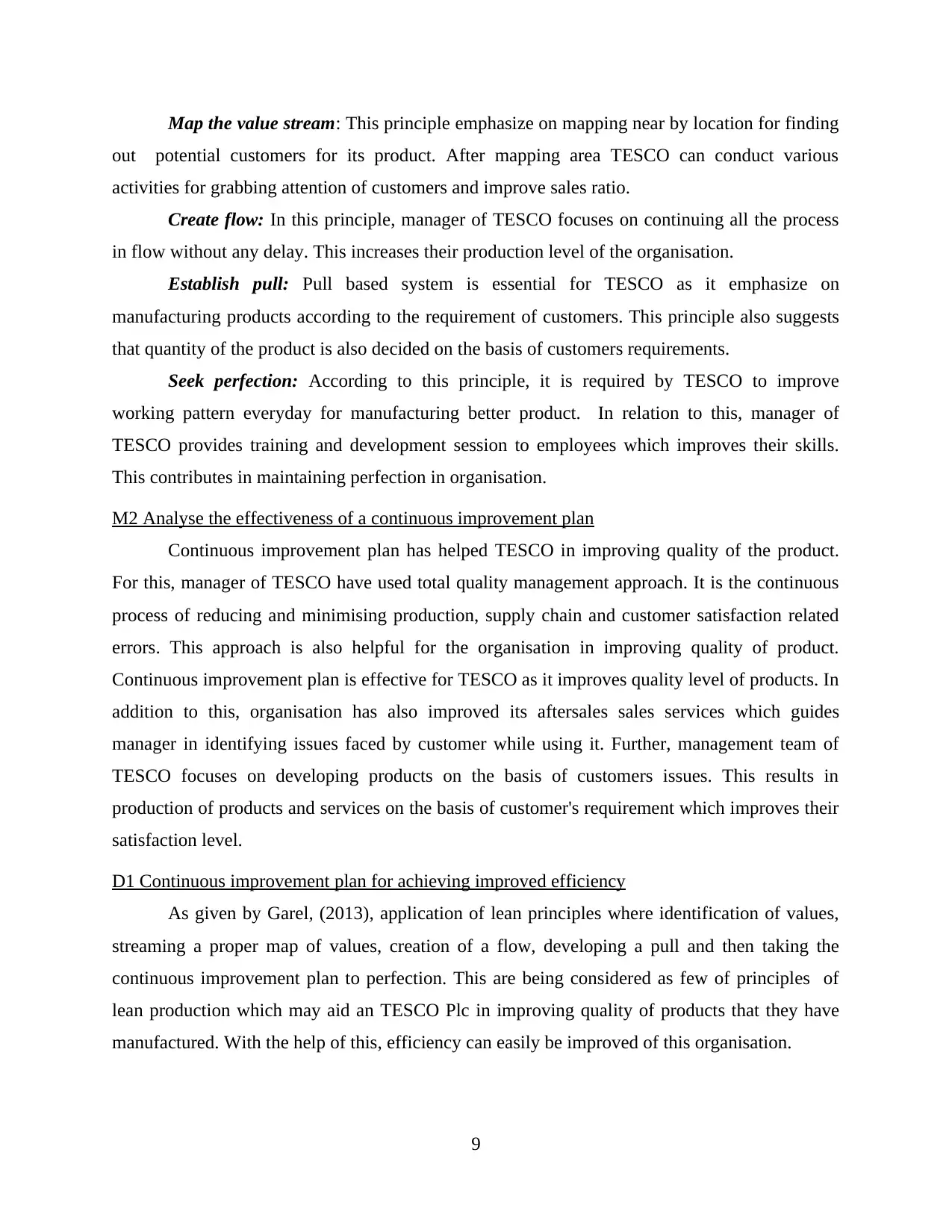
Map the value stream: This principle emphasize on mapping near by location for finding
out potential customers for its product. After mapping area TESCO can conduct various
activities for grabbing attention of customers and improve sales ratio.
Create flow: In this principle, manager of TESCO focuses on continuing all the process
in flow without any delay. This increases their production level of the organisation.
Establish pull: Pull based system is essential for TESCO as it emphasize on
manufacturing products according to the requirement of customers. This principle also suggests
that quantity of the product is also decided on the basis of customers requirements.
Seek perfection: According to this principle, it is required by TESCO to improve
working pattern everyday for manufacturing better product. In relation to this, manager of
TESCO provides training and development session to employees which improves their skills.
This contributes in maintaining perfection in organisation.
M2 Analyse the effectiveness of a continuous improvement plan
Continuous improvement plan has helped TESCO in improving quality of the product.
For this, manager of TESCO have used total quality management approach. It is the continuous
process of reducing and minimising production, supply chain and customer satisfaction related
errors. This approach is also helpful for the organisation in improving quality of product.
Continuous improvement plan is effective for TESCO as it improves quality level of products. In
addition to this, organisation has also improved its aftersales sales services which guides
manager in identifying issues faced by customer while using it. Further, management team of
TESCO focuses on developing products on the basis of customers issues. This results in
production of products and services on the basis of customer's requirement which improves their
satisfaction level.
D1 Continuous improvement plan for achieving improved efficiency
As given by Garel, (2013), application of lean principles where identification of values,
streaming a proper map of values, creation of a flow, developing a pull and then taking the
continuous improvement plan to perfection. This are being considered as few of principles of
lean production which may aid an TESCO Plc in improving quality of products that they have
manufactured. With the help of this, efficiency can easily be improved of this organisation.
9
out potential customers for its product. After mapping area TESCO can conduct various
activities for grabbing attention of customers and improve sales ratio.
Create flow: In this principle, manager of TESCO focuses on continuing all the process
in flow without any delay. This increases their production level of the organisation.
Establish pull: Pull based system is essential for TESCO as it emphasize on
manufacturing products according to the requirement of customers. This principle also suggests
that quantity of the product is also decided on the basis of customers requirements.
Seek perfection: According to this principle, it is required by TESCO to improve
working pattern everyday for manufacturing better product. In relation to this, manager of
TESCO provides training and development session to employees which improves their skills.
This contributes in maintaining perfection in organisation.
M2 Analyse the effectiveness of a continuous improvement plan
Continuous improvement plan has helped TESCO in improving quality of the product.
For this, manager of TESCO have used total quality management approach. It is the continuous
process of reducing and minimising production, supply chain and customer satisfaction related
errors. This approach is also helpful for the organisation in improving quality of product.
Continuous improvement plan is effective for TESCO as it improves quality level of products. In
addition to this, organisation has also improved its aftersales sales services which guides
manager in identifying issues faced by customer while using it. Further, management team of
TESCO focuses on developing products on the basis of customers issues. This results in
production of products and services on the basis of customer's requirement which improves their
satisfaction level.
D1 Continuous improvement plan for achieving improved efficiency
As given by Garel, (2013), application of lean principles where identification of values,
streaming a proper map of values, creation of a flow, developing a pull and then taking the
continuous improvement plan to perfection. This are being considered as few of principles of
lean production which may aid an TESCO Plc in improving quality of products that they have
manufactured. With the help of this, efficiency can easily be improved of this organisation.
9
⊘ This is a preview!⊘
Do you want full access?
Subscribe today to unlock all pages.

Trusted by 1+ million students worldwide
1 out of 20
Related Documents
Your All-in-One AI-Powered Toolkit for Academic Success.
+13062052269
info@desklib.com
Available 24*7 on WhatsApp / Email
![[object Object]](/_next/static/media/star-bottom.7253800d.svg)
Unlock your academic potential
Copyright © 2020–2025 A2Z Services. All Rights Reserved. Developed and managed by ZUCOL.


